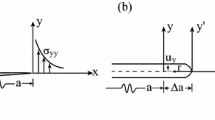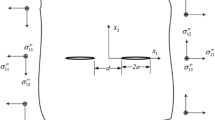Abstract
A consistency check is proposed to examine numerical results, from the physical point of view, for strongly interacting multiple crack problems in isotropic elastic materials, in bimaterials, and in orthotropic materials, respectively. The basic idea starts from the projected conservation relations of the well-known J k -integral vector. The path chosen to evaluate the J k -vector is one surrounding each of the multiple cracks completely in a local coordinate system such that the total contributions of the multiple cracks to the J-integral in a global coordinate system could be formulated by a summation of the projected values of the J k -vector. The summation should be zero, due to the remote stress conditions. The consistency check is then introduced which is concerned only with the stress intensity factors at all crack tips, the stress parallel to the faces of every crack, and the oriented angle of every crack. Thus, no matter how the numerical results for the interacting crack problems are derived by whatever kind of technique, any mistakes occurring in manipulations which may escape the traditional comparisons with previously known results in some special cases can then be recognized and avoided, since they will certainly lead to unsatisfactory conclusions contrary to the consistency check in relatively general cases. The consistency check is performed for two interacting cracks in the three kinds of materials mentioned above. It is concluded that the check really provides a powerful tool for examining the numerical results for the multiple crack problems.
Similar content being viewed by others
References
Binienda, W., Wang, A.S.D. and Delate, F. (1991). Analysis of bent crack in unidirectional fiber reinforced composites. International Journal of Fracture 47, 1-24.
Chen, Y.Z. (1984a). General case of multiple crack problems in an infinite body. Engineering Fracture Mechanics 20, 591-579.
Chen, Y.Z. (1984b). Multiple crack problems of antiplane elasticity in an infinite body. Engineering Fracture Mechanics 20, 767-776.
Chen, Y.H. (1996). On the contribution of discontinuities in the neartip stress field to the Jintegral. International Journal of Engineering Science 34, 819-829.
Chen, Y.H. and Hasebe, N. (1994). Interaction between a main-crack and a parallel micro-crack in an orthotropic plane elastic solid International Journal of Solids and Structures 31, 1877-1890.
Chudnovsky, A., Dolgopolsky, A. and Kachanov, M. (1987a). Elastic interaction of a crack with a micro-crack array - Part I. International Journal of Solids and Structures 23, 1-10.
Chudnovsky, A., Dolgopolsky, A. and Kachanov, M. (1987b). Elastic interaction of a crack with a micro-crack array - Part II. International Journal of Solids and Structures 23, 11-21.
Dundurs, J. (1969). Discussion of a paper by D.B. Bogy. ASME Journal of Applied Mechanics 36, 650-652.
Erdogan, F. (1978). Mechanics Today, Pergamon Press, Oxford, Vol. 4, 1-86.
Erdogan, F., Gupta, G.D. and Cook, T.S. (1972). Mechanics of Fracture(Edited by G.C. Sih), Noordhoff, Groningen, Vol. 1.
Gong, S.X. and Horii, H. (1989). General solution to the problem of micro-cracks near the tip of a main crack. Journal of the Mechanics and Physics of Solids 37, 27-46.
Gross, D. (1982). Stress intensity factors of systems of cracks. Ingenieur Archiv 51, 301-310.
Herrmann, A.G. and Herrmann, G. (1981). On energy release rates for a plane crack. ASME Journal of Applied Mechanics 48, 525-528.
Horii, H. and Nemat-Nasser, S. (1985). Elastic fields of interacting inhomogenities. International Journal of Solids and Structures 21, 731-745.
Horii, M. and Nemat-Nasser, S. (1987). Interacting micro-crack near the tips in the process zone of a macro-crack. Journal of the Mechanics and Physics of Solids 35, 601-629.
Hutchinson, J.W., Mear, M.E. and Rice, J.R. (1987). Crack paralleling an interface between dissimilar materials. ASME Journal of Applied Mechanics 54, 828-832.
Isida, M. and Noguchi, H. (1994). Distributed cracks and kinked cracks in bonded dissimilar half planes with an interface crack. International Journal of Fracture 66, 313-337.
Ju, J.W. and Chen, T.M. (1994a). Effective elastic modulus of twodimension brittle solids with interacting micro-cracks, Part I: Basic formulations. ASME Journal of Applied Mechanics 61, 349-357.
Ju, J.W. and Chen, T.M. (1994b). Effective elastic modulus of twodimension brittle solids with interacting micro-cracks, Part II: Evolutionary damage models. ASME Journal of Applied Mechanics 61, 358-366.
Kachanov, M. (1987). Elastic solid with many cracks: a simple of analysis. International Journal of Solids and Structures 23, 23-43.
Kachanov, M. and Montagut, E. (1986). Interaction of a crack with certain micro-crack arrays. Engineering Fracture Mechanics 25, 625-636.
Kachanov, M. and Laures, J.P. (1989). Threedimensional problems of strongly interacting arbitrarily located penny-shaped cracks. International Journal of Solids and Structures 23, 11-21.
Krajcinovic, D. (1989). Damage Mechanics. Meccanica et Materialia 8, 117-197.
Lekhnitskii, S.G. (1963). Theory of Elastic of an Anisotropic Body, HoldenDay, San Francisco.
Lu, H. and Lardner, T.J. (1992a). Mechanics of subinterface cracks in layered material. International Journal of Solids and Structures 29, 669-688.
Lu, H. and Lardner, T.J. (1992b). A note on the interface crack. ASME Journal of Applied Mechanics 59, 252-254.
Ma, H. and Chen, Y.H. (1996). The explicit formulation for Jkvector in both isotropic and anisotropic cases. International Journal of Fracture 75, R25-R28.
Mauge, C. and Kachanov, M. (1994). Anisotropic material with interacting arbitrarily oriented cracks: Stress intensity factors and crack-micro-crack interaction. International Journal of Fracture 65, 115-139.
Obata, M., NematNasser, S. and Goto, Y. (1989). Branched cracks in anisotropic elastic solids. ASME Journal of Applied Mechanics 56, 858-864.
Rice, J.R. (1968a). A pathindependent integral and the approximation analysis of strain concentration by notches and cracks. ASME Journal of Applied Mechanics 35, 379-386.
Rice, J.R. (1968b). Mathematical analysis in the mechanics of fractures. Fracture(Edited by H. Liebowitz), Academic Press, New York, Vol. 2, 191-311.
Rose, L.R.F. (1986). Micro-crack interaction with a main crack. International Journal of Fracture 31, 233-246.
Suo, Z. (1989). Singularities interacting with interface and cracks. International Journal of Solids and Structures 25, 1133-1142.
Zhang, T.Y. and Lee, S. (1993). Stress intensity factors of interface cracks. Engineering Fracture Mechanics 44, 539-544.
Zhang, T.Y. and Li, J.C.M. (1992). Interaction of an edge dislocation with an interfacial crack. Journal of Applied Physics 72, 2215-2226.
Zhao, L.G. and Chen, Y.H. (1996). Interaction of a semiinfinite crack and a parallel subinterface crack. International Journal of Fracture 76, 279-291.
Author information
Authors and Affiliations
Rights and permissions
About this article
Cite this article
Chen, YH., Hasebe, N. A consistency check for strongly interacting multiple crack problems in isotropic, bimaterial and orthotropic bodies. International Journal of Fracture 89, 333–353 (1998). https://doi.org/10.1023/A:1007476430508
Issue Date:
DOI: https://doi.org/10.1023/A:1007476430508




